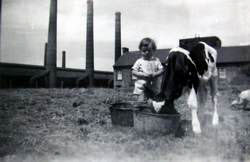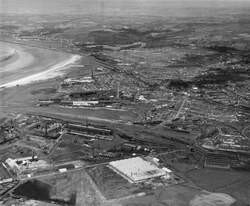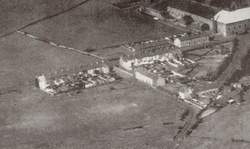Abandoned Communities ..... Machynys
The Machynys peninsula lies south of the town of Llanelli, at the eastern end of Carmarthenshire. It is assumed that it was once an island, at least at high tide, “ynys” being the Welsh for island. Until the middle of the nineteenth century there was a farm on Machynys, and not much else, but then came an explosion in industrial production in the Llanelli area. Amidst the factories, brickworks, and chemical plants of the Machynys peninsula two small communities grew up. They remained in existence until their demolition around 1970.
The development of industry on the Machynys peninsula and elsewhere in the Llanelli area was made possible by an act of enclosure passed by Parliament in 1807. Rights of common were extinguished by the act, and the land was divided and sold to private owners. An embankment, or bulwark, was built around the peninsula to protect it from flooding by the sea.
The first significant industry on the peninsula was the production of bricks. At least three brick works were opened in the 1850s and 1860s, using clay from pits adjacent to the factories. The first group of houses, Brick Row, may have been built at this time.
At the same time, however, developments were taking place around Llanelli that would lead to the area gaining a foremost position in the manufacture of tinplate. Not far away, at Kidwelly, tinplate production had started in 1737. In Llanelli itself the Dafen works opened in 1848. Then in 1872 Morewood and Rogers began iron and tinplate manufacture on the Machynys peninsula in what later became known as the South Wales Works. Soon afterwards, in 1875, tinplate production started at the Burry Works, converted from the former Rosser’s Arsenic Works.
In the early 1870s wrought iron was still the main component of tinplate. Within a few years, however, improvements in the production of steel meant that tinplate factories were motivated to convert to the use of steel. The South Wales Works were one of the first to make the conversion, in 1878.
Two further tinplate works were opened at a later date on the Machynys peninsula. They were the Richard Thomas Mills, established in 1910, and the Burry Extension Works, opened in 1912 a short distance south west of the Burry Works. All four works underwent several changes of ownership. They enjoyed expansion and innovation during periods of high demand, but were compelled to reduce production and working hours when demand fell. In the 1880s, for example, Llanelli was responsible for about one eighth of the tinplate production of Great Britain. Much of its output was being exported to the USA, but the McKinley tariff of 1890, designed to protect the production of tinplate in the USA itself, led to a major slump in demand for British tinplate.
Wikipedia has a short history of tinplate manufacture at this address. An excellent account of Llanelli’s tinplate trade, as seen from a wide range of perspectives, can be found in John Edwards (ed.), Tinopolis, 2nd edition published by Llanelli Civic Society, 2008. Or for a comprehensive history of the tinplate and other industries in the Llanelli area go to R S Craig et al., The Industrial and Maritime History of Llanelli and Burry Port 1750 to 2000, Carmarthenshire County Council, 2002.
The first chapter in Tinopolis describes the various stages in the production of tinplate. It is well illustrated with photographs. After bars of steel had been rolled into sheets, teams of four men would heat the sheets (the furnaceman), insert them into the rolls (the rollerman), pass the sheets back to the rollerman (the behinder), and double them and place them in the squeezer (the doubler). The plates were then trimmed and passed through a number of chemical processes. Finally a thin layer of tin was applied and the surface polished.
Some of the jobs in the production line were done by women. These included separating plates that were sticking to each other, and the final polishing. Plates were usually separated with a piece of lead held in the palm, but if necessary a machete-like tool known as a hanger could be brought into use.
Women also tended to be in the majority in the checking department. They were required to look out for any of fifty odd possible faults that might give rise to “wasters”. Excessively thick edges, for example, were likely to be due to poor doubling, while any corners found folded over would be attributed to the tinman and his assistant.
Reminiscences of an individual tinplate worker appear in a chapter in Tinopolis by David Morris. David Morris describes the clothing worn by the workers, and the effects of the intense heat in which they operated. He also mentions the tiredness that would begin to set in during the night shift, but this was likely to be alleviated around 3.00 am when one team member would break into Calon Lan. Others would soon join in, and the team might finish off with a couple of Sankey and Moody songs.
The development of industry on the Machynys peninsula and elsewhere in the Llanelli area was made possible by an act of enclosure passed by Parliament in 1807. Rights of common were extinguished by the act, and the land was divided and sold to private owners. An embankment, or bulwark, was built around the peninsula to protect it from flooding by the sea.
The first significant industry on the peninsula was the production of bricks. At least three brick works were opened in the 1850s and 1860s, using clay from pits adjacent to the factories. The first group of houses, Brick Row, may have been built at this time.
At the same time, however, developments were taking place around Llanelli that would lead to the area gaining a foremost position in the manufacture of tinplate. Not far away, at Kidwelly, tinplate production had started in 1737. In Llanelli itself the Dafen works opened in 1848. Then in 1872 Morewood and Rogers began iron and tinplate manufacture on the Machynys peninsula in what later became known as the South Wales Works. Soon afterwards, in 1875, tinplate production started at the Burry Works, converted from the former Rosser’s Arsenic Works.
In the early 1870s wrought iron was still the main component of tinplate. Within a few years, however, improvements in the production of steel meant that tinplate factories were motivated to convert to the use of steel. The South Wales Works were one of the first to make the conversion, in 1878.
Two further tinplate works were opened at a later date on the Machynys peninsula. They were the Richard Thomas Mills, established in 1910, and the Burry Extension Works, opened in 1912 a short distance south west of the Burry Works. All four works underwent several changes of ownership. They enjoyed expansion and innovation during periods of high demand, but were compelled to reduce production and working hours when demand fell. In the 1880s, for example, Llanelli was responsible for about one eighth of the tinplate production of Great Britain. Much of its output was being exported to the USA, but the McKinley tariff of 1890, designed to protect the production of tinplate in the USA itself, led to a major slump in demand for British tinplate.
Wikipedia has a short history of tinplate manufacture at this address. An excellent account of Llanelli’s tinplate trade, as seen from a wide range of perspectives, can be found in John Edwards (ed.), Tinopolis, 2nd edition published by Llanelli Civic Society, 2008. Or for a comprehensive history of the tinplate and other industries in the Llanelli area go to R S Craig et al., The Industrial and Maritime History of Llanelli and Burry Port 1750 to 2000, Carmarthenshire County Council, 2002.
The first chapter in Tinopolis describes the various stages in the production of tinplate. It is well illustrated with photographs. After bars of steel had been rolled into sheets, teams of four men would heat the sheets (the furnaceman), insert them into the rolls (the rollerman), pass the sheets back to the rollerman (the behinder), and double them and place them in the squeezer (the doubler). The plates were then trimmed and passed through a number of chemical processes. Finally a thin layer of tin was applied and the surface polished.
Some of the jobs in the production line were done by women. These included separating plates that were sticking to each other, and the final polishing. Plates were usually separated with a piece of lead held in the palm, but if necessary a machete-
Women also tended to be in the majority in the checking department. They were required to look out for any of fifty odd possible faults that might give rise to “wasters”. Excessively thick edges, for example, were likely to be due to poor doubling, while any corners found folded over would be attributed to the tinman and his assistant.
Reminiscences of an individual tinplate worker appear in a chapter in Tinopolis by David Morris. David Morris describes the clothing worn by the workers, and the effects of the intense heat in which they operated. He also mentions the tiredness that would begin to set in during the night shift, but this was likely to be alleviated around 3.00 am when one team member would break into Calon Lan. Others would soon join in, and the team might finish off with a couple of Sankey and Moody songs.
One
Industry, housing, and a farm
The northern part of the Machynys peninsula in the foreground, with the town of Llanelli and the hills of Carmarthenshire beyond it. The South Wales Works appears on the left about a third of the way up the photograph, with the Richard Thomas Mills to the right of it. The Burry Extension can be seen on the lower left, and the Burry Works to its right. The new building in the front is the Machynys Foundry.
This photograph, taken in 1953, has been supplied by the National Museum of Wales
The community of Bwlch-


